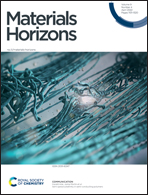Origin of the anisotropic-strain-driven photoresponse enhancement in inorganic halide-based self-powered flexible photodetectors†
Abstract
Strain engineering has been recognized as a critical strategy in modulating the optoelectronic properties of perovskite halide materials. Here, we demonstrate a self-powered, flexible photodetector based on CsPbBr3 thin films with controllable compressive or tensile strain of up to ±0.81%, which was produced in situ via a sequential two-step deposition on bent polymer substrates. The best photoresponsivity of ∼121.5 mA W−1 with a photocurrent of 5.15 μA was achieved at zero bias under a power intensity of 0.47 mW cm−2 for the maximum tensile strain of +0.81%, which corresponds to a ∼100.2% increase relative to that of the unstrained case. The in situ tensile strain adjusted the band alignments, making them favorable for enhanced charge transport and thus a higher photoresponse. The structural origin of this superlative balanced photodetection performance was systematically revealed to be associated with the distortion of coupled PbBr6 octahedra and the atomic displacement within the octahedron.



 Please wait while we load your content...
Please wait while we load your content...